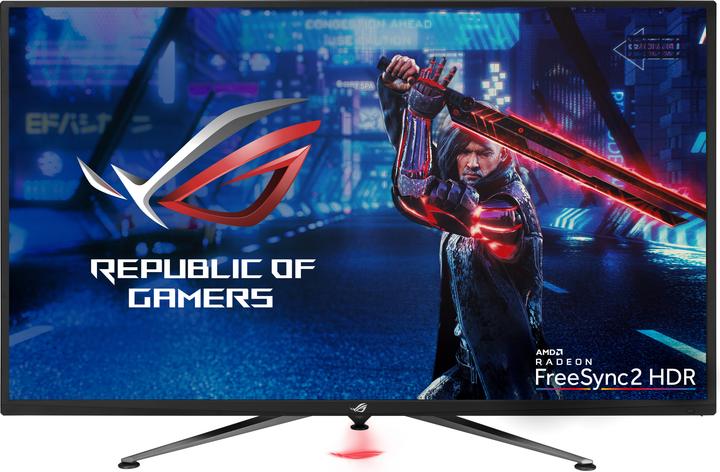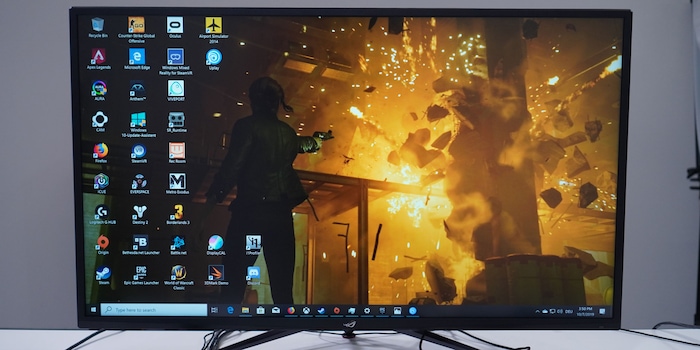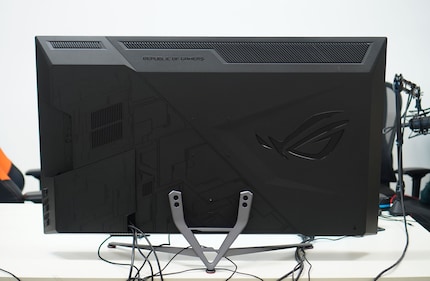

Asus XG438Q tested: More monitor is not possible and yet it is not perfect
43 inches, UHD, 120 Hz, Freesync 2 and HDR. On paper, Asus' new high-end monitor sounds like the absolute ultimate. Unfortunately, there's a catch, but it's not (only) Asus' fault.
Bigger is better. I can agree with this maxim almost without reservation when it comes to monitors and televisions. As the owner of a 34-inch ultrawide for several years, I already feel that my monitor is a bit small again. Asus' new monster is just what I need. It is the first 43-inch monitor with a refresh rate of 120 Hz, UHD resolution and HDR. However, the holy trinity also comes with a hefty price tag.

As the test will show, the price is not beyond all doubt.
Specifications and external features
Asus doesn't skimp on the specifications:
- Size: 43-inch VA panel
- Resolution: 3840×2160 pixels
- Refresh rate: 120 Hz
- Colour space coverage: sRGB 125%, DCI-P3: 90%
- Response time: 4 ms
- Features: HDR-10, Freesync 2 HDR
- Connections: 3 x HDMI 2.0, 1 x Displayport 1.4, 2 x jack
At almost 23 kilograms and 7.5 centimetres thick, the Asus XG438Q is no lightweight. The stand takes up another 15 centimetres behind the monitor, meaning that the display can never be less than around 23 centimetres away from the end of the table.

Other than that, the monitor with its black matt plastic frame is relatively discreet - unless you switch on the RGB lighting, which projects the ROG logo onto the table. However, the projector was not included with me.
Image quality and performance
Theory is one thing. I want to know how the monitor performs when gaming. The first thing you notice, understandably, is the enormous size. We also use a 43-inch device in the studio for our Let's Plays, but only with a resolution of 1080p because of the streaming. Now that I'm sitting alone and directly in front of it, the monitor seems huge. And after a few rounds of "Apex Legends" and "CS:GO", I even get a bit dizzy. Maybe I'll get used to it over time. At the moment, however, the device actually seems a few inches too big for my desk.

Apart from that, gaming on the Asus XG438Q is excellent. The VA display shows no trace of ghosting, input lag or screen tearing. The latter is prevented by AMD's Freesync 2 technology. This now also works with Nvidia cards such as the RTX 2080 Ti installed in our digitec PC. At first, I thought the lack of G-Sync was a guaranteed no-go. But Freesync 2 also synchronises the monitor and graphics card perfectly. Regardless of whether a game displays more than 120 fps or less, I can't detect any screen tearing.

The viewing angles are a little poor and the colours fade relatively quickly when you move to the side. But if you're sitting directly in front of it, whether alone or in pairs, it doesn't matter.
I have selected "Custom" for the monitor presets, called GameVisual. This looks the most natural and the image appears strong and rich in contrast. This is also confirmed by the test with our X-Rite i1 display measurement device. The colour space coverage for sRGB is 99.8 %. For Adobe RGB it is still 81.3% and for DCI P3 an impressive 92.7%. This means that the monitor is even suitable for image and video editing. The static contrast of 3600:1 is slightly below the advertised 4000:1, but I never noticed this as a problem when playing games.
Asus promises 600 nits for the HDR10 certification. When tested, I even measured up to 655 nits in the centre of the monitor. However, the illumination is rather uneven. The differences are up to 100 nits. However, I only noticed this when I was looking at a plain-coloured background image. The lighting on the right edge of the screen is also somewhat darker. But only if you look very closely.
Operation and sound quality

For once, I have a few positive words for the OSD operation. You can navigate through the menus using a joystick on the right-hand side. Click to confirm. There are four more buttons, one of which is used to switch off the monitor, but these are optional. Everything can be controlled with the joystick. The menus are tidy and clearly organised. You'll find picture-in-picture mode, aura lighting, blue light filter, dynamic dimming and shadow boost. For some reason, the FPS display doesn't work for me. It unwaveringly displays 120 fps, even though this is definitely not the case.
The monitor can be tilted forwards and backwards so that you can adjust it to your sitting position.
The two built-in 10-watt speakers produce a decent sound that is more than sufficient for everyday applications and the odd video.
The problem with HDR and 120 Hz
Where there is something to complain about is with the two flagship functions: HDR10 and 120 Hz. Let's start with HDR. The technology, which is supposed to provide a higher-contrast and more dynamic picture, disappoints in most cases. There are probably two reasons for this. Firstly, Windows 10 is still not really mature enough for the use of HDR. You will notice this as soon as you switch the HDR lever in the Windows video settings. Then everything looks pale in one fell swoop. In other words, exactly the opposite of what is commonly associated with HDR.
The problem is that Windows forces HDR on all SDR content, making it look completely washed out. The solution is to only turn on HDR when you're watching an HDR film or playing an HDR game. Some games even work without you activating HDR in Windows. Incidentally, you can choose between Gaming HDR and Cinema HDR (and Freesync HDR on AMD cards) for your monitor. I did the test with Gaming HDR.


Click here for the full-size image: Ghost Recon Breakpoint without HDR
Click here for the full-size image: Ghost Recon Breakpoint with HDR
The result for games also fell short of my expectations. Whether "Ghost Recon Breakpoint", "Destiny 2", "Metro Exodus" or "Borderland 3", the HDR version always looked paler than without. Details are more recognisable because overexposed parts are darkened and underexposed parts are brightened - but the image is completely desaturated at the same time. I can't make any sense of that. It looks best when you hardly notice the difference, as in "Metro Exodus". In "Ghost Recon", the change from light to dark works a little better with HDR. Stairwells or basements are no longer simply pitch black, as is usually the case.
Apart from that, I have lost all desire to buy an HDR monitor. Even different brightness settings couldn't change the result. In addition to Windows, computer monitors are apparently simply not at the same level as televisions when it comes to HDR. That or me and my colleagues, to whom I have also shown the games, are victims of oversaturated images, so that the HDR settings in games seem so pale. On the other hand, I'm pretty happy with my HDR-enabled TV. I've only experienced the pallor phenomenon there once, and that was in "Assassin's Creed Origins".

Click here for the full-size image: Borderlands 3 without HDR
Click here for the full-size image: Borderlands 3 with HDR
Another negative point of HDR is the power consumption. In some games, you won't notice any difference. Others, such as "Borderlands 3", consume up to 20 per cent more power. On our box with an i9-9900K and an RTX 2080 Ti, the fps drops from over 70 to around 60 when HDR is activated.
In addition to HDR, the 120 Hz should also be treated with caution. The monitor can display it without any problems, but in combination with the native resolution of 3840×2160 pixels, you can rarely utilise its potential. SLI and Crossfire are a thing of the past and even with an RTX 2080 Ti, I rarely achieve over 100 fps in the latest titles. So you're paying for something that you can rarely utilise to its full potential. There are of course exceptions such as "Apex Legends" or "Gears 5", and if you primarily play slightly older titles such as "Overwatch" or "Counter Strike GO", you're definitely pushing the Asus to its limits.
However, the 50 fps in "Ghost Recon Breakpoint" or the 60 fps in "Borderlands 3" once again impressively showed me that UHD resolution still demands too much performance even today.
Conclusion: A great monitor - in theory

With the Asus XG438Q you get a lot for your money. It is equipped with every conceivable function that a gamer's heart desires and the picture quality is impressive despite the VA panel. The only thing to criticise is the uneven illumination, but even that will hardly bother you in everyday life. What you need to think about before buying is why you are buying this monitor. Do you want the largest possible monitor that still fits on a desk with all the bells and whistles? Then the Asus delivers what it promises. Just be aware that HDR on a PC is still associated with a few hurdles. And you won't experience UHD in combination with 120 Hz very often either.
If you are unsure or like it even coarser, wait for the Acer CG437K. It has almost the same features, but delivers 144 Hz and 1000 nits. The former is even more nonsensical with UHD, but the latter may improve the HDR experience. I'll probably stick with Ultra Wide and wait until someone presents something in 40-inch format.
If you have had any other experiences with HDR on a PC, let me know in the comments.
Being the game and gadget geek that I am, working at digitec and Galaxus makes me feel like a kid in a candy shop – but it does take its toll on my wallet. I enjoy tinkering with my PC in Tim Taylor fashion and talking about games on my podcast http://www.onemorelevel.ch. To satisfy my need for speed, I get on my full suspension mountain bike and set out to find some nice trails. My thirst for culture is quenched by deep conversations over a couple of cold ones at the mostly frustrating games of FC Winterthur.



